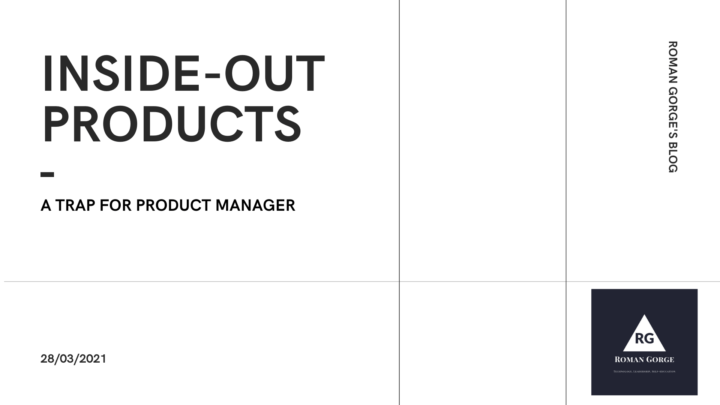Let’s imagine a mid-size IT company. It was founded around a decade ago by group of smart engineers who are probably still around as executives.
Back in early days, the company built a highly successful and innovative product. The product allowed quickly expand worldwide, made company profitable and created foundation of today’s success.
A decade later, the company is not a start up any longer. Some processes are around, engineering is busy adding new features, marketing is creating nice slide decks and sales are sweating to deliver their quotas.
Everything looks great. But market became more competitive, customers are more demanding today than a year before and YoY growth is not that impressive as it used to be. The company wants continue to grow and it needs new products in portfolio that will rock the market.
What is inside-out product?
A common scenario looks like below:
- CEO decides that new product should be launched
- The rest of executives discuss it and somebody says – “I have a great idea! We need to build product X”
- The idea is sent down the chain of command – product management adds it to the roadmap, engineering assigns resources and etc.
- Everybody works really hard to build the product according executives expectations
What is a flaw here?
This is a classical example what is called “inside-out product”. The company takes an idea that was born inside and start implementing it without validating with market demands or even ask customers.
You may hear next arguments why company need to develop product X:
“This is market is huge, we need to build something for it.”
“CEO says this product aligns with company’s vision”
“Our customers liked product Y, so they will like product X”
“Our sales team is saying we can make fortune with this product!”
While it sounds like logical arguments, those are warning signs. Unfortunately, majority of us are not product and marketing geniuses like Steve Jobs, so we cannot rely on our or somebody else’s gut feeling. The reality is – customers decide what product will be successful, not executives or board of directors.
Of course, some inside-out products will succeed but it is a lottery. So, if you see that impulse “we need it”, instead of “the customer need it”, it is a good time to stop and analyze what is happening (check out this article to learn more how to do such analysis).
Product Management comes into a room
The cornerstone of product management organization is to understand customer’s needs and transform them into products, features and solutions. That’s why any “next big thing” development should start with market analysis and customers’ feedback collection. For “inside-out” products, however, this step is skipped.
Product manager get an assignment when idea (or even design) is ready for implementation and high management expects results and delivery plan. Product manager is in a trap from day one. There is no time and resources to perform thorough analysis, so everybody concentrates on plans, JIRA tasks, epics, sprints and etc.
Another issue that product manager will face with inside-out products is value proposition and marketing story. Because nobody asked customers in the first place, so it is not clear what benefits new product brings and what problems does it solve. As a result, marketing and product management start to invent justification why customers need new product.
This is when truisms appear in sales collaterals and product promotions materials.
“Best in class solution…”
“Unprecedented high value…”
“Outstanding quality and availability…”
When you don’t have actual customer story or need behind the product idea, then you can only brag and throw defiant statements.
The issue here that people (and most customers are people) are very sensitive to insincerity and non authenticity. They can feel it and become annoyed. The reason is simple – they don’t see what problems the product solves and how does it connect to their needs and reality.
How to avoid the trap?
First of all, product manager should ask questions about new product idea:
- Who and how conducted market research?
- Do we have customers’ sentiment or requests for this product?
- Why it is important to customers?
If the answers are not clear or do not exist at all – pull the Andon Cord.
Be ready to push back. Inside-out products typically originated in the top ranks of the company, so be prepared to hold the ground.
Collect real customer data – use your tools to validate the idea among existing customers. The golden rule is – validate on many, try on few.
